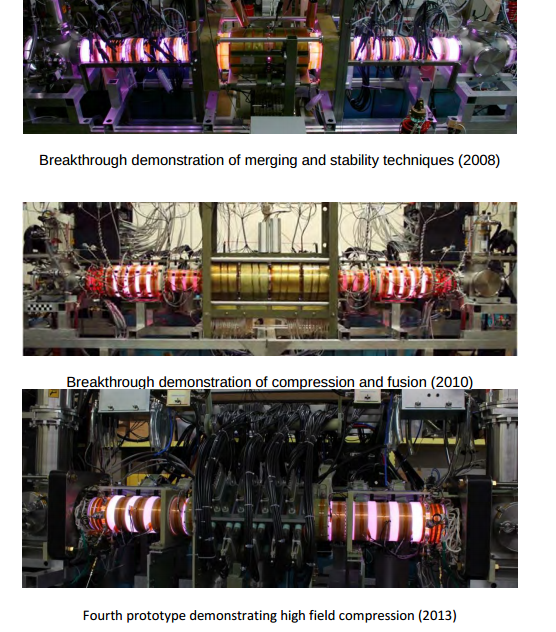Helion Energy’s Fusion Engine is the only demonstrated fusion energy source capable of producing both on demand and baseload power at low cost and with minimal environmental impact. Employing a patented staged electromagnetic compressor and direct energy conversion, the Fusion Engine efficiently harnesses fusion energy employing fuel derived solely from water. This IAEA award winning and DOE validated prototype generated the required fusion energy output that allows for commercialization of economical fusion by 2019. By removing complex tritium systems and steam turbines, the Fusion Engine can be constructed faster and with reduced capital costs. And unlike current nuclear systems, Helion’s fusion technology is inherently safe and generates only clean byproducts. Helion holds the key to unlock the long sought after promise of endless fusion energy.
They got $5 million from DOE and are raising $35 million. The chief researcher John Slough also has a NASA funded direct fusion rocket project.
The Fusion Engine will Enable Profitable Fusion Energy in 2019
Developed by Engineers to be Commercially Practical
Fast, affordable development (50 MW module, truck-sized)
Fusion is clean, safe, and generates no hazardous byproducts
Fusion energy is converted directly to electricity, eliminating capital costs
Uses demonstrated physics
Scientifically Legitimate
Fusion Engine technology supported by DOE Office of Fusion Energy
IAEA best of peer reviewed fusion paper – 2011
Field leading advocates and independent validation
4th prototype operational in Redmond, WA
How the Fusion Engine Works
Formation -Plasma is generated by ionizing gas in a Field Reversed Configuration
Accelerator -Plasma is accelerated to high velocities using pulsed magnetic fields
Collision -Two plasmas are collided and compressed to transfer kinetic energy to heat
Burn Chamber -Conditions are formed to initiate fusion of fuel
Energy Generation -Fusion plasma is converted to i) direct energy ii) fuel for further operation
Market Demand
The annual worldwide expenditure on electricity is over 3 trillion dollars. It is estimated that over 25 trillion dollars will be invested by 2030 to meet this increasing demand. The Fusion Engine is scalable and compatible with centralized and distributed infrastructure and can access new undeveloped and remote markets. The market is currently lacking a carbon free source of electricity that can meet demand for baseload and on demand power.
Competitive Advantage
Helion Energy is uniquely qualified to succeed in bringing the Fusion Engine to market:
* Helion’s technology is the only proven, practical, reactor assembly in existence with greater fusion output than any private competitor.
* The Fusion Engine was designed from the ground up to be a competitive commercial device, yet is based on demonstrated physics, technologies and Helion’s patented scientific breakthrough.
* The world renowned scientific and technical team has a deep knowledge of the science, and unique experience in the technologies and the scales required for a commercial reactor.
* The science of the Fusion Engine has been rigorously demonstrated and peer reviewed.
* Helion has radically reduced risk by validating the technology with over $5 M in DOE funding.
* The Fusion Engine is compact (semi-truck sized) will be able to generate lower cost electricity than current baseload power sources.
* The management team won the 2013 National Cleantech Open Energy Generation competition and awards at the 2014 ARPA-E Future Energy Startup competition.
Revenue Model
Helion Energy’s long term strategy is to generate revenue based on a royalty model of electricity produced with projected electricity prices of 40-60 $/MWhr (4 to 6 cents per kwh). Penetration of the new capacity market is estimated at 20% of market growth (2.5%) per annum eventually reaching 50% of new power generation worldwide – $52 B/yr. Gradual displacement of existing plants provides for continued growth to 20% of world electrical generation after 20 years with a net return of over $300 billion.
Early revenue is generated by sale of electricity produced by the pilot plant. Acquisition and exit opportunities exist after pilot plant operation in 2019.
Capital Requirements – Financials
Helion Energy’s technology has received $4+ M non-dilutive U.S. Department of Energy seed funding to demonstrate the concept at increasing scales. The team has contributed another $100k towards business development and ongoing technology development. Helion Energy is seeking a $35M Series B. This three year round has several funding gates and will demonstrate a reactor scale fusion core that will exceed the performance of any fusion energy source ever built. Series B will also demonstrate direct electricity generation and finalize the commercial power plant design. Subsequently, a commercial 50 MW pilot plant will be constructed over a two year period .
If you liked this article, please give it a quick review on ycombinator or StumbleUpon. Thanks

Brian Wang is a Futurist Thought Leader and a popular Science blogger with 1 million readers per month. His blog Nextbigfuture.com is ranked #1 Science News Blog. It covers many disruptive technology and trends including Space, Robotics, Artificial Intelligence, Medicine, Anti-aging Biotechnology, and Nanotechnology.
Known for identifying cutting edge technologies, he is currently a Co-Founder of a startup and fundraiser for high potential early-stage companies. He is the Head of Research for Allocations for deep technology investments and an Angel Investor at Space Angels.
A frequent speaker at corporations, he has been a TEDx speaker, a Singularity University speaker and guest at numerous interviews for radio and podcasts. He is open to public speaking and advising engagements.


